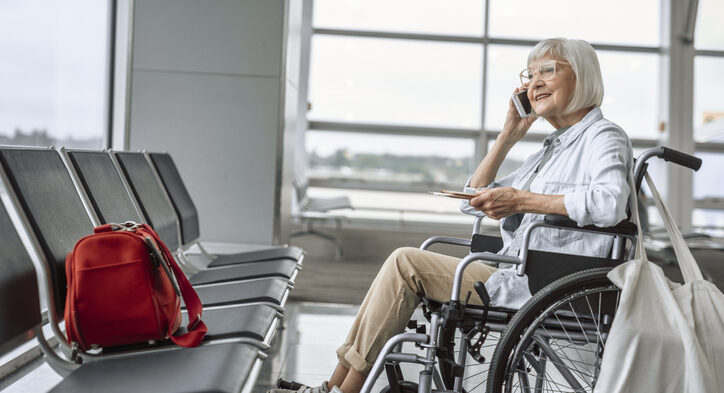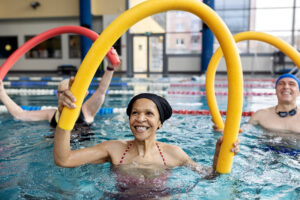The holiday season is a great time to visit family and friends. However, if you have a disability and use mobility devices or other medical equipment, holiday travel can be complicated. Luckily, most major modes of transportation have accessible options. In this article, we’ll explore how to travel accessibly on planes, trains, and automobiles.
Planes
If you’re traveling long distances and want to cut your travel time as much as possible – air travel may be your solution.
Although the thought of air travel can be daunting, the good news is that due to the Air Carrier Access Act, airlines are required to assist with boarding, deplaning and connecting flights, accommodating seating assignments that meet disability-related needs and stowing assistive devices.
Assistive devices are “any piece of equipment that assists a passenger with a disability in coping with the effects of his or her disability. These devices are intended to assist passengers with a disability to hear, see, communicate, maneuver, or perform other functions of daily life.” Assistive devices include, but are not limited to:
- Crutches, canes and walkers
- Braces/ prosthetics
- Wheelchairs
- Hearing aids
- Portable oxygen concentrators
- Continuous positive airway pressure machines
- Prescription medications and any medical devices needed to administer medication, such as syringes and auto-injectors
You can bring your assistive device into an aircraft cabin and stow it in an overhead compartment, under the seat in front of you or in a designated stowage area. Larger items, such as wheelchairs, are held in the plane’s cargo portion and must be returned to you as close as possible to the aircraft’s door.
The U.S. Department of Transportation recommends that you confirm that your wheelchair will fit in the cargo hold (if you are traveling on a small craft) and attach straightforward assembly and disassembly instructions before your flight.
Trains
Amtrak is the primary rail operator in the United States. You can request accessibility assistance when booking your ticket and speak with an agent on arrival to board the train.
Amtrak trains accommodate most manual and battery-powered mobility devices 27.5 inches wide and 48 inches long and smaller. Although, they may be able to accommodate larger devices depending on the type of car you ride in. While boarding the train, Amtrak staff will use mobile lifts and bridge plates to help you get from the platform into the train car in your wheelchair. If you have a non-collapsible mobility device, you must remain seated in it during your ride. However, if it is collapsible, you may sit in an accessible train seat and stow your device nearby.
Amtrak also allows oxygen equipment and service animals on their trains. Service animals must be kept on a leash or harness and sit at your feet or under your seat.
Automobiles
If you are attending a local event or celebration, you may choose to travel by car to your location.
Rideshare
Several rideshare companies offer accessible transportation. Uber provides “Uber WAV” wheelchair-accessible vehicle rides for users who use motorized wheelchairs or scooters. WAV rides cost about the same as a basic UberX ride, and your driver will have passed a third-party certification course and be able to help you enter and exit the vehicle. In addition, you can bring a service animal and companions with you on the ride.
Similar to Uber, Lyft offers “Lyft Wheelchair” rides in wheelchair-accessible vehicles that can accommodate non-folding or motorized wheelchairs and scooters. Lyft also provides “Lyft Assisted” rides where your driver will meet you at the front door of your pick-up location, help you enter and exit the vehicle and escort you to the door of your destination. Lyft Assisted drivers can help you with light mobility devices such as canes, walkers and foldable wheelchairs. You can bring your service animal or companion on a Lyft ride.
These services are only available in some cities, so check with Lyft, Uber or your preferred rideshare company before you travel.
Private vehicles
Riding with a family member or friend can be more familiar than riding with a stranger in a rideshare or transport service. If you plan to ride in a private vehicle, ensure your driver can accommodate your mobility or medical equipment beforehand.
Maxim Healthcare Services is a nationwide provider of home healthcare services; check out our services. If you want to read more about holiday considerations, read: Holiday Travel with Your Medically Complex Child.



